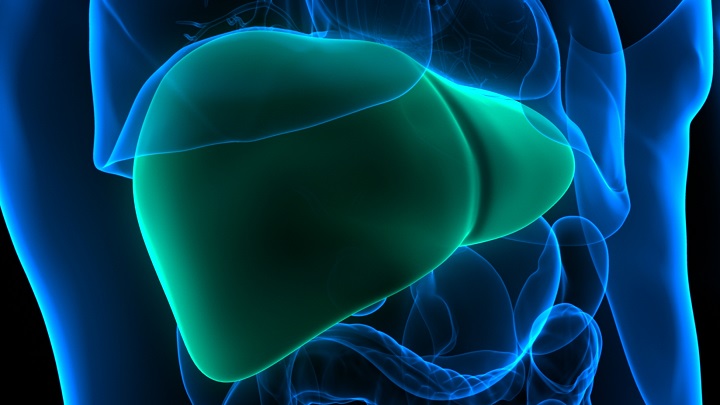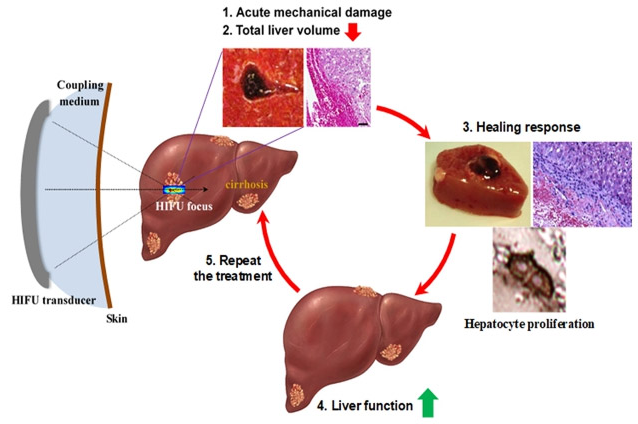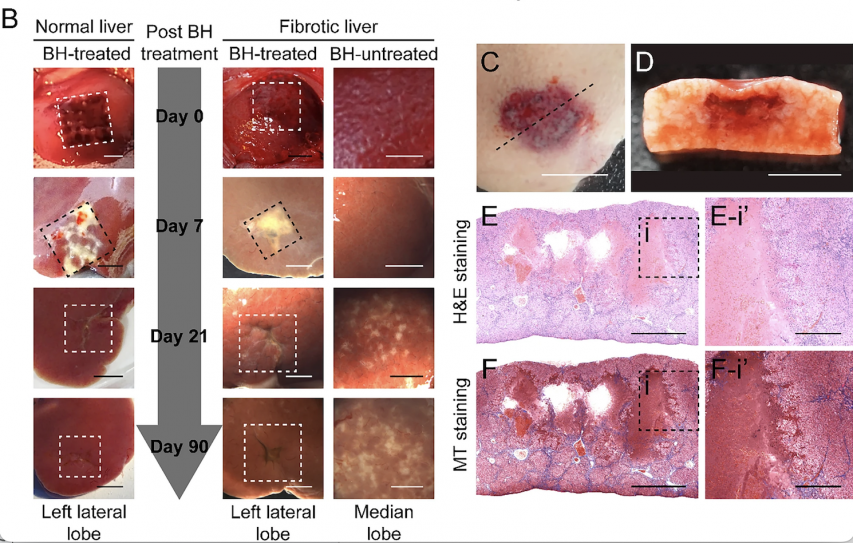[Feature] Boiling Histotripsy: A Breakthrough Treatment for Liver Cirrhosis
A research team led by Pahk Ki-joo from the Dept. of Biomedical Engineering at Kyung Hee University has suggested a promising new treatment for cirrhosis. Their study, published on July 2, 2024, in Scientific Reports, a sister journal of Nature, highlights the potential of boiling histotripsy (BH) in reversing liver fibrosis. The article, titled Boiling Histotripsy Exhibits Anti-Fibrotic Effects in Animal Models of Liver Fibrosis, demonstrates groundbreaking results that could transform cirrhosis treatment.

Liver |
Photo: University of Barcelona (web.ub.edu) |
Understanding Cirrhosis and Current Treatment Limitations
Cirrhosis is a severe liver condition caused by chronic inflammation and fibrosis, leading to scar tissue that hinders normal liver function. Advanced cirrhosis often results in serious complications such as jaundice, hepatic encephalopathy, and liver cancer.
Although the disease is serious, the treatment options are limited. Prof. Pahk explained, “Once the liver reaches a cirrhosis state, its tissues are unable to regenerate. Many studies have been conducted to find a treatment, but there is still no way to reverse cirrhosis. Currently, the only available options for managing the disease are preventing further fibrosis, treating complications, and liver transplantation.”
In line with this, a new approach to reverse cirrhosis is needed. Prof. Pahk explained that while transplantation is currently the only way for a cirrhosis patient to regain normal liver function, this option is limited by the shortage of available liver. Furthermore, some patients’ liver conditions worsen while they wait for a transplant, ultimately rendering them ineligible for the procedure.
Given these challenges, the research team sought an innovative approach to address the limitations of existing treatments.
BH Technology: A New Approach to Regenerate Liver Tissue
The team explored BH technology to regenerate fibrotic liver tissue. This technique destroys organ tissue using high-intensity focused ultrasound. In this process, targeted tissue vibrates to create bubbles that burst, breaking down fibrotic areas without damaging surrounding healthy tissue. Prof. Pahk explained that a previous study found this technology enables the liver to regenerate normal tissue while destroying cancerous areas, which led them to explore its application for cirrhosis treatment.
Using laboratory rats, the researchers induced liver fibrosis with thioacetamide, a chemical commonly used in fibrosis studies. They then divided the rats into a control group and a treatment group subjected to BH. This allowed them to compare the effects of BH on damaged liver.

Conceptual diagram for BH treatment for cirrhosis | Photo: KHU (khu.ac.kr) |
Promising Results in Reversing Fibrosis
After 90 days of observation, the team concluded that the technology had a significant effect on improving fibrotic tissue. Typically, levels of alpha smooth muscle actin, also known as α-SMA, collagen, and certain proteins increase as the liver becomes fibrotic. However, the treated group showed a decrease in these substances, indicating that the progression of their cirrhosis was reduced.
Moreover, the technology improved regenerative capacity. Asialoglycoprotein receptor 1 and the cluster of differentiation 26 are key markers that indicate this capacity, and the treated group showed elevated levels of these markers.
Furthermore, the study found that the technology can improve liver health. Substances such as aspartate aminotransferase, alanine aminotransferase, and bilirubin are key indicators of liver function, and the treated group showed overall improvement in these markers. Importantly, no adverse side effects or signs of inflammation were observed during the regeneration process.
The Transformative Potential of BH Technology
BH technology offers a precise and effective method for cell destruction. Unlike traditional techniques that rely on heating energy and were limited by the heat sink effect, where flowing blood disrupts heat transfer, BH achieves higher accuracy through acoustic cavitation.
Prof. Pahk explained the study will bring hope to cirrhosis patients: “I believe the BH technology will significantly enhance quality of life. For some whose livers are damaged, they will feel quite better even if the liver function recovers by just 10%.” He also highlighted the challenges of liver treatment, including the difficulty of accessing the organ behind the ribs and the complexities of transplantation, emphasizing the potential of BH to simplify these hurdles.
Expanding Applications and Future Research
The potential applications of BH technology extend beyond cirrhosis. Prof. Pahk said, “The same technology for treating liver cancer was approved by the U.S. Food and Drug Administration last year. This indicates that BH technology holds significant promise for use in various types of disease.” He added that, theoretically, the technology can be applied to any fibrotic or cancerous tissue.
The research team plans to build on their findings by conducting studies on larger animals and progressing toward clinical trials. Moreover, they aim to develop a specialized device using BH technology.
The research team successfully validated the feasibility of a new treatment approach for liver cirrhosis. Following these results, they are working toward clinical application. Their achievements and continuous efforts will offer a new hope to patients.
There are no registered comments.
Trend News
- 1
- 2
- 3
NEWS LETTER
The University Life delivers stories about Kyung Hee University through an email newsletter every morning.
I agree to the collection of personal information.





